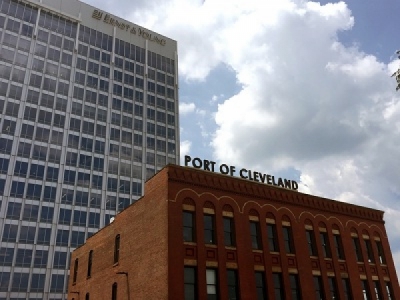
Posted on January 17, 2017
By Jay Miller, Carin's Cleveland Business
Although 2016 was not a banner year for shipping through the docks along Lake Erie and the Cuyahoga River, it wasn’t awful, either. The local results mirrored the results for the Great Lakes-St. Lawrence Seaway inland waterway system.
In particular, the Cleveland-Europe Express, the only regularly scheduled cargo and container service between the Great Lakes and Europe, suffered from low-rate competition.
“(The year) was not as strong as we’d hoped,” said Will Friedman, president and CEO of the Cleveland-Cuyahoga County Port Authority, in an interview. “It was one of the worst years for ocean transport. Shippers were offering crazy-low rates from East Coast ports.”
The Journal of Commerce, a shipping industry watcher, reported earlier this month that world container ship capacity has grown at 8% a year since 2008, while shipping volume has grown by only 3% a year.
Idle ships led to lower rates, which, Friedman said, negated the cost advantage of moving goods between Cleveland and Europe, India or beyond. It was cheaper to shuttle cargo or containers on rail cars or in trucks between Cleveland and ports in New York, Philadelphia and Norfolk, Va., for ocean crossing.
According to The St. Lawrence Seaway Management Corp., total cargo shipments on the system was 30.3 million metric tons for the period from March 21 to Nov. 30, 2016, the latest figures available. That’s 5.9% below 2015’s 32.2 metric tons.
On the Cleveland docks, cargo tonnage was down from 536,000 metric tons of cargo to 530,500 tons, down 1%. The down year also broke a string of six years of international cargo growth.
Friedman said demand was strong for some bulk cargoes, including stone and coal, although the Lake Carriers Association, which represents Great Lakes ship owners, reported that iron ore shipments to Cleveland docks was down 15.6%, from 3.2 million tons to 2.7 million tons.
The port received 400,000 tons of imported steel, which Friedman said was “pretty typical.”
The decline of the European service, though, no longer affects the Port Authority financially.
The Cleveland-Europe Express was introduced in 2014, with the Port Authority subsidizing one vessel sailing a month back and forth between Cleveland and Antwerp, Belgium. For the first year, the Port Authority pledged $800,000 a month, which could be offset by cargo revenue. The subsidy the first year was $3.7 million.
In 2015, the capacity doubled to two sailings per month, and as of spring 2016, Spliethoff Transport BV, the Port Authority’s partner on the service, added more sailings.
But the Port Authority’s financial commitment has declined. The Port Authority’s 2017 budget projects a subsidy of $1 million, down from $1.8 million in 2016.
The Port Authority sees the service as a long-term investment to stimulate cargo traffic through the port. In May, Lubrizol Corp. of Wickliffe committed to regular shipments of specialty chemicals produced at its Avon Lake plant from the Cleveland docks, the service’s first major commitment from an exporter.
The Port Authority is looking forward to startup of work building the Lake Erie wind farm. Lake Erie Energy Development Co. (LEEDCo) plans to ship the pieces and parts of the six wind turbines to the local docks for assembly before they are towed out to the construction site on barges. Friedman said the Port of Cleveland could become an assembly site for other lake or inland wind farms.
Much of the bulk shipments into the private docks along the Cuyahoga River are commodities — iron ore, grain, limestone, cement and coal — that originate elsewhere in the Great Lakes.
That kind of shipping is the bread and butter of Middleburg Heights-based Interlake Steamship Co. Its fleet of 10 ships, some 1,000 feet long, shuttle coal between the Iron Range of northern Minnesota to the steel towns further south in the Great Lakes.
“It’s been OK. We’ve seen a steady year,” said company president Mark Barker of his company’s 2016 operations. “Steelmaking has been running about 70% utilization. That’s not a fantastic number, but it’s not a horrible number.”
That soft production at the steel mills resulted in the temporarily idling of several of Interlake customers’ mines, he said.
One factor affecting both the local port authority and the ship operators is insufficient dredging of shipping lanes.
“The Great Lakes have quite a substantial backlog in dredging,” Barker said. “Our channels are functional, but they are not maintained to the full design. In some cases, that restricts us.”
That means that ships, to keep from scraping bottom in parts of the shipping lanes, must lighten their loads, raising operating costs.
In Cleveland, the U.S. Army Corps of Engineers stopped dredging the Cuyahoga River as it, the Port Authority and the Ohio Environmental Protection Agency sparred for more than two years over where to put the sediment that builds up on the river bottom.
As on the lakes, shallower shipping lanes lighten the loads of ships that drop off stone, iron ore and other cargo at docks along the river.
The Army Corps says the material is no longer toxic and is now safe to deposit in Lake Erie. The Port Authority and the Ohio Environmental Protection Agency disagree and want the sediment placed along the waterfront.
The Army Corps finally agreed to dredge last October, after more than a year without dredging.
Friedman said he’s optimistic the federal Water Infrastructure Improvements for the Nation Act, passed in December, will solve the dispute, which has been mired in federal court for several years. The act requires the Army Corps to accept the water quality standards set by state EPAs.
Source: Carin’s Cleveland Business





